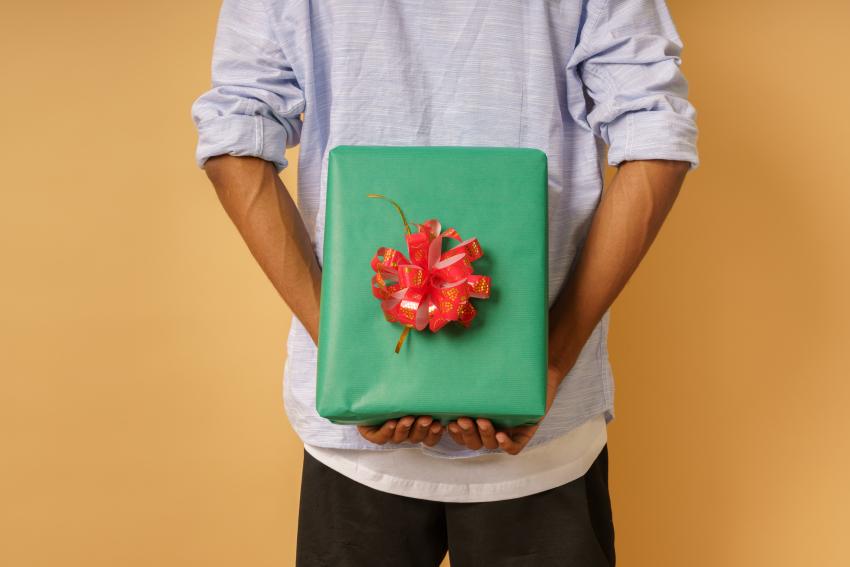Why giving a gift has never been a simple gesture

Gift-giving is one of the oldest and most widespread human traditions. It has always symbolised gratitude, recognition, and the wish to connect with others. While the objects, forms, and rituals have evolved greatly over thousand of years, the core meaning of gift-giving remains the same: to show someone that they matter and to express gratitude. At our translation agency, AbroadLink, we know it well — and we’re here to tell you about it.
Índice de contenidos
Index of contents
Index du contenu
Inhaltsverzeichnis
Indice dei contenuti
Ancient origins: from shells to Christmas trees
The history of gift-giving is as old as humanity itself. In prehistoric times, early humans exchanged simple objects, such as shells, animal teeth and carved stones, as symbols of alliance, seduction, or gratitude. Jewellery dating back more than 100,000 years in South Africa bears witness to these early symbolic gestures.
In ancient times, gift-giving became both ritualistic and social. In Egypt, offerings were made to gods and pharaohs. In Greece and Rome, gifts were part of popular festivals such as the Saturnalia (to celebrate the god Saturn), where figurines or dried fruits were exchanged and social barriers temporarily disappeared. The Romans also introduced the concept of ‘strenae’, the ancestor of New Year's gifts.
During the Middle Ages, gifts came to symbolise loyalty. Vassals gave part of their wealth to their lords, while royal courts used diplomatic gifts, such as jewellery, fabrics, and horses, to display prestige.
Gift-giving became more personal in modern times. Bourgeois families began exchanging personal gifts like books, portraits, or jewellery. By the 19th century, the rise of the Christmas tree and Santa Claus popularised Christmas gifts in Europe and America.
Today, gift-giving has become both a social custom, a personal pleasure, and a vast global market. However, it still retains its original purpose: to strengthen bonds. These bonds sometimes extend beyond the living: in many cultures, the dead also continue to receive gifts. In Latin America, for example, during the ‘Día de los Muertos’, families place offerings such as flowers, traditional dishes, objects, or even favourite drinks on altars to honour the memory of loved ones and maintain a symbolic link with them. Similar acts can be found in other traditions, such as offerings made in Asian temples. Gifts, therefore, have a universal history and symbolism: whether expressing affection, respect, or remembrance, their purpose remains the same, bringing people together.
How different cultures view gifts
Although gift-giving is universal, its codes vary widely from one continent to another:
- In Asia, the act is highly codified. Wrapping can matter more than the object itself. In China, certain colours (red, gold) are lucky, while others should be avoided. Gifts should never be given in sets of four, a number associated with death. In Japan, it is considered impolite to open a gift in front of the giver, out of modesty. It is also frowned upon to accept it with only one hand (both hands should always be used).
- In the Western world, gift-giving is more spontaneous, linked to major celebrations such as Christmas, birthdays, weddings, and Mother's and Father's Day. Humour is often welcome, as is the case of ‘novelty gifts’.
- In Africa, the act of giving is often collective. Food, livestock, or textiles are offered to strengthen solidarity and support the community.
- In the Middle East, giving a gift is primarily a sign of hospitality and respect. Gifts are always presented with the right hand or both hands, as the left is considered impure.
Gifts can take many different forms:
- Material (jewellery, books, clothing)
- Immaterial (trips, experiences, subscriptions)
- Edible (wine, tea, pastries)
- Symbolic (flowers, crafts, religious objects)
The occasions also vary: Lunar New Year in Asia, Christmas in Europe and America, Eid al-Fitr and Eid al-Adha in Muslim countries, weddings and rites of passage in Africa. Each culture integrates gift-giving into its own rhythms and values.
What not to do when giving a gift
While gift-giving bring people closer, it can also create awkwardness if chosen or presented incorrectly.
The choice of gift:
Certain objects can carry negative connotations:
- In China, giving a watch evokes death
- In Italy, a knife symbolises the breaking of a bond
- In Russia, an even number of flowers is reserved for funerals
- In Western countries, overly expensive gifts may embarrass the recipient, making them feel indebted
How the gift is presented:
The gesture matters as much as the object itself. In many cultures, unwrapped gifts are considered careless. In Muslim countries or India, offering a gift with the left hand is considered disrespectful as it signifies impurity. Leaving the price tag on is universally frowned upon.
How the gift is received:
Receiving a gift also follows unspoken rules. In China or Japan, gifts are not opened immediately. Refusing a gift can be seen as an insult. Failing to show gratitude, through a smile, a word, or a card, is considered impolite everywhere.
Social and symbolic aspects
In some societies, a gift calls for a counter-gift: not giving a gift in return breaks social balance. In Western countries, re-gifting is frowned upon if discovered. Finally, a gift perceived as self-serving, that is, offered to influence, corrupt, or manipulate, is condemned across the world. Most of the time, gifts are given without expecting anything in return; we simply do so because we care about the person concerned.
Conclusion
Giving a gift is a universal act, yet never a trivial one. Behind every object, experience, or symbol lies a social language of codes, traditions, and taboos, which vary as widely as cultures themselves. Giving and receiving gifts requires cultural sensitivity, and, in the world of translation, localisation. That's why understanding the culture of the country where you are located, or where your translations will be read, is crucial. From the very first humans to the present day, the act of gift-giving endures as a timeless way to say: "you matter to me".
Other articles you may be interested in:




Add new comment